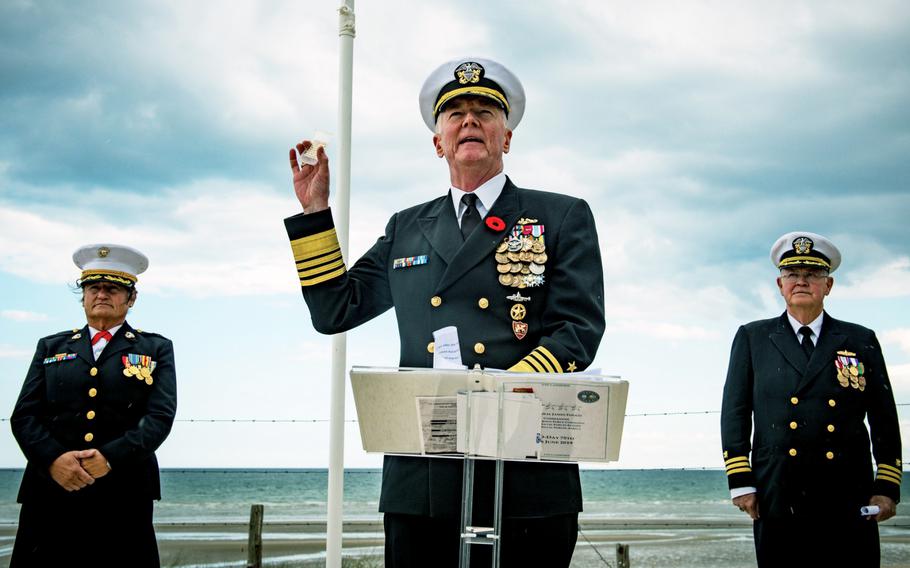
Adm. James Foggo, commander, U.S. Naval Forces Europe and Africa, holds sand from Utah beach in Normandy, France, as he delivers remarks during a dedication ceremony for a Lone Sailor monument on June 6, 2019. The sand came from Foggo's father who took part in the Normandy invasion as a member of the Canadian forces. (Jonathan Nelson/U.S. Navy)
U.S. frogmen slogged through choppy waves to the Normandy beaches on D-Day, demolishing mines and removing other obstacles as German soldiers fired at them from hilltop perches.
Those underwater demolition teams cleared the way for the largest amphibious assault in history on June 6, 1944, which led to the liberation of Western Europe and contributed to the defeat of Nazi Germany a year later.
The frogmen were among the first to step ashore and die. They carried out their mission despite having little defense against relentless machine gun and artillery fire.
They were among the Normandy war dead honored Thursday during a dedication of a Lone Sailor statue on a plaza overlooking Utah Beach. It was one of several ceremonies in the region commemorating the 75th anniversary of D-Day.
“The Lone Sailor monument represents all these sailors and Marines that lost their lives at sea — and what they have given to us,” said Adm. James Foggo, head of the Navy’s Europe and Africa command, according to a statement. “Victory in Europe would not have been possible without the determination and sacrifice of those sailors, soldiers and Marines here on Utah Beach, 75 years ago today.”
The statue is one of 17 Lone Sailor monuments and is the first to be placed outside the United States.
Foggo noted that the frogmen were the forerunners of the Navy SEALs and a crucial part of the invasion force.
The frogmen swam and waded through waters in a combat zone with no wetsuits or diving gear, submerging only as long as they could hold their breaths. The Navy adopted scuba gear in 1948 and started the SEALs in 1962.
An explosive technician named Dennis Shyrock described how the Germans cut down many who were landing, Foggo said, according to the statement.
“The ocean water around him ‘looked like pure blood. That was sickening.’ But he added, ‘We couldn’t stop doing our job.’ ”
Elisabeth Wright, the granddaughter of one of the first frogmen to come ashore, attended the ceremony.
“We are all honored to live your grandfather’s story through you and hope to measure up to his sacrifice when our service is complete,” Foggo said, according to the statement.
Foggo, whose father landed in Normandy with the Canadian forces, stood with German Command Sgt. Major Juergen Stark, whose grandfather was a German soldier in World War II.
“(Stark) believes as I do,” Foggo said. “That although we will never forget D-Day and World War II, we will constantly learn from the mistakes of the past to become stronger friends and Allies.”